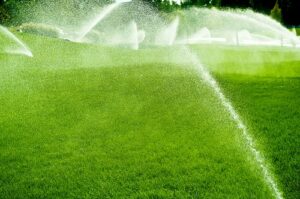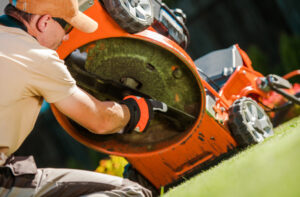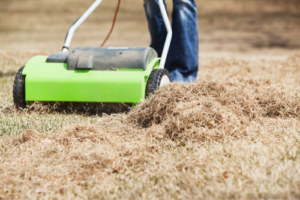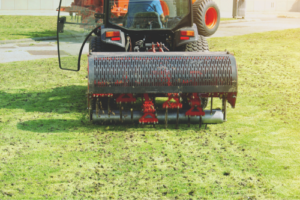
Whether you are in Red Deer or Calgary, Alix or Airdrie, Olds or Okotoks, when it comes to caring for your lawn, homeowners are prone to repeating the same mistakes. Here are a few things NOT to do:
Common Lawn Care Mistakes to Avoid
1. Scalping the Lawn
If you think you are doing your lawn a favor by giving it a “good cut” to start the season, you are wrong! Mowing grass too short can put it into shock and is very harmful to the plant. Similar to the leaves on a tree, grass plants absorb sunshine through their leaves and make food (glucose) through photosynthesis. They need their leaves to absorb sunshine to make glucose to eat and grow.
Scalping your lawn stresses the grass, making it less healthy and more prone to disease, and makes space for weed growth.
2. Overwatering
 When it comes to watering, over watering can be just as destructive as watering too little.
When it comes to watering, over watering can be just as destructive as watering too little.
It is better to water deeply, less often, then to water a little bit frequently.
If you water too frequently, the grass will fail to develop deep roots because there’s no need for it to reach deep down into the soil to find moisture. Watering the correct amount allows the grass to grow deep roots, creating a lawn that’s much stronger, healthier and better equipped to survive drought conditions.
As a general rule, most lawns require about an inch of water per week, but that varies widely based on weather, soil conditions, and grass species.
Over watering discourages the grass plant from developing a deep root system.
Learn more about lawn watering in our blog, “Lawn Watering Guidelines: Tips and Signs of Over and Underwatering”.
3. Mowing the Grass too Short
As we shared under “Scalping Your Lawn”, you are actually harming your grass by cutting it too short – not doing it a favour. Cutting your grass too short:
- makes the plant less healthy and more prone to disease
- makes room for weeds to sneak in and grow, encouraging weed growth, as there is now less competition for the same space
We recommend cutting your grass to a height of 2-1/2″ to 3″. Cutting it at this height will encourage the grass to develop a deeper root system to support the longer blades, require less water, promote growth, prevent weeds and discourage insect pests. Plus never cut off more than 1/3 of the grass blade at any one time.
Keeping your grass cut at a short height (below 2-1/2″) makes it less healthy, more prone to disease and makes space for weed growth.
Learn more about this common lawn care mistake in our blog, “Common Lawn Care Mistakes: How to Identify When Your Grass is Cut Too Short”.
4. Dull Mower Blades
 Mowing with dull blades will tear the glass blade and not leave a clean cut. A torn or ripped blade of grass is also more prone to disease and insect damage. We recommend to check your lawnmower blades at the start of the season, and sharpen if necessary. Plus make sure you periodically check the blades throughout the lawn mowing season to make sure they are still sharp.
Mowing with dull blades will tear the glass blade and not leave a clean cut. A torn or ripped blade of grass is also more prone to disease and insect damage. We recommend to check your lawnmower blades at the start of the season, and sharpen if necessary. Plus make sure you periodically check the blades throughout the lawn mowing season to make sure they are still sharp.
Dull mower blades tear and rip the grass, making it more prone to disease and insects.
5. Misapplication of Fertilizer
 At Earth Smart Property Solutions we have been mixing and applying lawn fertilizers for over 30 years, so we know how complicated it can be.
At Earth Smart Property Solutions we have been mixing and applying lawn fertilizers for over 30 years, so we know how complicated it can be.
While most homeowners know it’s important to fertilize their lawn, few know how to do it correctly. Applying the wrong fertilizer or applying too much fertilizer can do more harm than good. And the correct fertilizer can be ineffective if applied too sparingly or at the wrong time of year.
Common mistakes made when it comes to lawn fertilizers are:
- over fertilizing or applying too much
- applying at wrong time of the year
Over fertilizing can cause excess leaf growth and limit root growth. Apply fertilizer too heavy and it can burn your lawn.
We offer a variety of fertilizer services. Please contact our offices if you have any questions.
Fertilizer is complicated. Misapplication can burn your lawn and limit root growth. Make sure you research before applying.
6. Bagging the Clippings
Leave the grass clippings on the lawn, as you mow, to decompose and provide moisture and nutrients. If the grass clippings clump together, make sure to rake them out so they don’t form a thick mat and suffocate the lawn.
Leave your grass clippings on your lawn to decompose and provide moisture and nutrients
Learn more about the benefits of mulching in our blog, “Mulching Grass: Benefits and Tips”.
7. Not Dethatching
 Thatch is the layer of dead organic lawn matter, such as grass clippings and shredded leaves that forms on top of the soil. If the layer of thatch is ½” thick or thicker, it can starve the lawn.
Thatch is the layer of dead organic lawn matter, such as grass clippings and shredded leaves that forms on top of the soil. If the layer of thatch is ½” thick or thicker, it can starve the lawn.
To help grass absorb sunlight, nutrients and water, it’s important to dethatch the lawn at least once a year, preferably in the spring.
Use a thatching rake or rent a dethatching machine.
If your layer of thatch is 1/2″ or thicker, be sure to dethatch once a year.
8. Not Aerating
 Aeration involves perforating the soil with small holes to allow air, water, and nutrients to penetrate deep into the root zone. This helps alleviate soil compaction and promotes healthy root growth.
Aeration involves perforating the soil with small holes to allow air, water, and nutrients to penetrate deep into the root zone. This helps alleviate soil compaction and promotes healthy root growth.
Core aeration is recommended once per year in the spring or fall.
Learn about our Core Aeration service here.
9. Not Overseeding
Overseeding helps fill in bare patches and thickens the lawn, reducing weed invasion and enhancing its overall resilience. Overseeding your lawn is important to ensure a healthy, thick and weed free lawn.
It is recommended every 3 to 4 years. Learn more about our Overseeding service here.
10. Neglecting Proper Lawn Maintenance Practices
Proper lawn maintenance extends beyond mowing, watering, and fertilizing. Neglecting other essential tasks such as regularly inspecting for pests and diseases can compromise the health and appearance of your lawn.
Regular inspection for pests and diseases allows for early detection and prompt treatment, preventing potential damage to the lawn. Incorporating these maintenance practices into your lawn care routine can contribute to a healthier, more resilient lawn over time.
Are you dreaming about a lush, green, healthy lawn? You can do it! And if you need a bit more help, we can help! Please contact us if you have any questions. We offer weed control, lawn fertilizer, weekly and biweekly mowing, core aeration, and overseeding services in Calgary, Red Deer and close surrounding communities.
Our Red Deer branch services the following surrounding areas:
- Alix
- Bentley
- Blackfalds
- Bowden
- Breton
- Clive
- Didsbury
- Delburne
- Eckville
- Innisfail
- Lacombe
- Olds
- Penhold
- Ponoka
- Raymond Shores
- Red Deer
- Rimbey
- Rocky Mountain House
- Springbrook
- Sylvan Lake
Our Calgary location services the following areas:
- Airdrie
- Chestermere
- Calgary
- Cochrane
- De Winton
- Langdon
- Okotoks
- Strathmore
Please note that all services may not be available in all areas.
Sources:
Popular Mechanics, 9 Biggest Lawn Care Mistakes [And How to Avoid Them]

Recent Comments